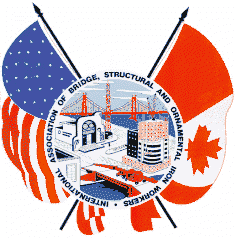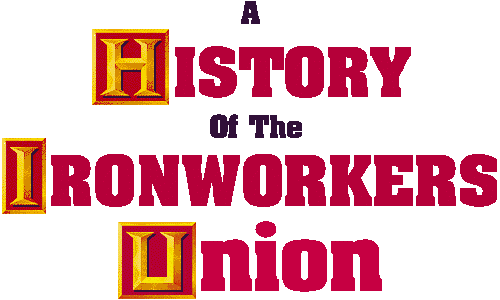|
|
|
|
Our History
A Union is Born
The Turbulent Years
The Conspiracy Trials
The Beginning of the
Morrin Era
The Depression and a New
Deal For Labor
World War II
Ironworkers Grow in the
1950's Part Two Part Three
John H. Lyons Jr.
Elected President
The Tradition Continues
Pathways to the 21st
Century Under The Leadership of General President Jake West
|
Part Four While the Ironworkers were suspended, the A. F. of L. Building Trades Department, generally recognized at the time as "the most militant part of the labor movement," took an unprecedented action. It held its annual Convention before, rather than after the A. F. of L. Convention, contrary to the Constitution of both the A. F. of L. and the Building Trades Department. At that November convention, the Building Trades Department received and adopted two resolutions submitted by the Lathers and Carpenters requesting annulment of a 1909 decision which granted reinforced concrete construction to the Iron Workers and a 1913 decision which granted the installation of solid steel and metal window frames to the Iron Workers. The suspended Iron Workers were astounded and furious at the passage of these resolutions. This clearly established that their current difficulties were going to be used to divide up the jurisdiction of the Iron Workers. The resolutions adopted by the Building Trades Department were then passed on to the A. F. of L. Convention for action. If adopted, this work would then be taken away from the jurisdiction of the Iron Workers. The International then sought ways to be quickly re-admitted to the A. F. of L., so they could speak against these resolutions on the floor of the A. F. of L. Convention. However, instead of being in a position to seek help from the A. F. of L., they were suspended and without representation. Not only would they be unable to seek help in the open-shop war with the large steel corporations; they instead were sitting on the outside while decisions were going to be made on whether or not their existing organization was going to be carved up by the labor movement itself. Unquestionably, the combination of the existing fight with the employers and a new fight against the other Building Trades Unions and the A. F. of L. for the right to represent workers on reinforcing rods and ornamental iron work would shortly lead to the demise of the Iron Workers as an effective and meaningful International Union. The Iron Workers indeed were on the brink of destruction! On November 13, 1917, the second day of the A. F. of L. Convention in Buffalo, NY, the Iron Workers announced that they had revoked the charters of Jersey City Local 189 and its sub-local. They would relinquish all claims to dock building in New York City. The Ironworkers were immediately seated in the convention and were in a position to request the help of the Federation in the growing open-shop war against the Iron Workers. President McClory told the delegates that the large steel corporations and the erectors associations were stepping up their efforts to crush the Union. He illustrated the outrageous situation by citing the fact that 75 percent of all men who followed the trade were members of this union, not withstanding the steel employers refusing to negotiate with or enter into any agreement with the International Association or any of its local unions. He pointed to the financial plight brought about by the decline in membership resulting from the enlistment in a short period of time of over 6 percent of the members into the armed forces and the loss of 1200 members in the New York pile-driving dispute. He stressed that the financial pressure of this loss in membership was magnified by the fact that the Iron Workers Union paid substantial death benefits because of the hazardous nature of the trade. These benefits were paid out of the general fund and in 1917 the benefit level had been doubled. Because of the high rate of accidental deaths, this had almost depleted the general fund. Although they were in the process of leveling the first general assessment since 1910, the treasury would be in dire straights before the effects of the assessment would be felt. The convention supported the appeal and adopted resolutions to urge the Secretary of War, the Secretary of the Navy, and the Council of National Defense to put pressure on the steel corporations and the erectors associations who had been refusing to recognize the Iron Workers Union. In addition, the Iron Worker delegates were successful in having the convention not support the Building Trades Resolutions to take reinforcing and ornamental iron work from the Iron Workers. The records from the convention would indicate, although the A. F. of L. Convention did not support the resolutions, the resolutions were not voted on at all and apparently still subject to future consideration. The action of President McClory in obtaining quick readmission into the A. F. of L. had indeed brought desirable results. The financial and organizational support of the A. F. of L. was obtained and the jurisdictional issue was not finalized. Notwithstanding the fact that the A. F. of L. Convention refused to support the Building Trades resolutions, the Building Trades nevertheless, proceeded to support the establishment of reinforcing rod local unions by the lathers, as well as the efforts of the Carpenters to negotiate agreements with employers covering the erection of steel windows and ornamental metal work. They proceeded under the premise that action had been authorized by the previous Building Trades Convention and not reversed by the A. F. of L. Convention. It was then evident that the only course of action was to bring the question back to the next A. F. of L. Convention. In December, 1917, McClory dispatched Vice President Ben Osborne to open a Washington office to represent the interests of the International Association during World War I. Osborne had to deal with eight different Government bureaus and boards involving construction, labor policy, wage adjustment, Navy Yard Riggers and other matters. He also had jurisdictional disputes with the International Longshoremen's Association, which wanted the Iron Workers shipyard riggers. McClory had the foresight to see that an office in Washington had to be established to protect the Union, and he had the good sense to send a man of Osborne's caliber. RYAN'S RELEASE In the year between conventions, the International received additional moral and physical support. On April 10,1918 President Wilson, notwithstanding his almost total preoccupation with the affairs of World War I, took the time and interest to commute the sentence of former Iron Worker General President Frank M. Ryan. This action indeed boosted the morale of the Iron Workers leadership. It had the effect of saying, from the highest office in the land, that the Iron Workers in their fight to represent their members were indeed being persecuted.
When former President Ryan returned to Chicago, he was welcomed back by hundreds of local and national labor leaders in one of the mast impressive receptions ever witnessed, in view of all the events that had taken place. It was a reception that heightened the spirits and bolstered the energies of those who were fighting so devotedly in the interests of the working man. President McClory immediately obtained the help of Ryan in his efforts to resolve the pile driving issue and the other jurisdictional questions at the next A. F. of L. Convention. A Few months later, McClory and Ryan presented a brief to the A. F. of L. Convention held in St. Paul, Minnesota. The brief aimed itself at the actions convention of the Building Trades Department, which had annuled the 1909 and 1913 decisions. It was scholarly and effective. It pointed out the various violations of the A. F. of L. Constitution, which had taken place in the passage of resolutions aimed at taking established work jurisdiction from the Iron Workers. The same brief was presented to the Building Trades Convention. The delegates of each convention voted concurrence that the Iron Workers had been dealt with unfairly and had not been given the protection afforded by the Constitutions of both the A. F. of L. and the Building Trades Department. Accordingly, the question was referred to the A. F. of L. Executive Council for action. In a few months it became clear that the A. F. of L. Executive Council was not going to act on the illegality of the action until the Iron Workers were willing to make certain concessions. McClory was discouraged and disenchanted.
Scroll to the top and click on "The Beginning of the Morrin Era - 1918 to 1929 - Part One"
[Home]
[Officers]
[Upcoming
Events] [Links
to Other Unions] |


